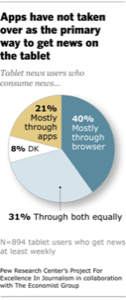The so-called tablet revolution in computing may still be young, but early research into how the devices are being used can tell us a lot.

About 11% of American adults now own a tablet, according to recent data from Pew’s Project For Excellence in Journalism. A large majority (77%) of those tablet owners use them every day and more than half consume news content from the devices.
The study has a number of interesting details for those who are interested in the news and publishing industries. Reading news is a huge part of what people use their tablets for, and as Pew’s report points out, those users are more engaged and often consume more news content than they did before. Tablets are beginning to supplant PCs and, to a lesser extent, print media as a source of news and long-form content.
Lessons Beyond the Media Industry
Even though Pew’s research is geared toward the media industry, it has instructive lessons for others as well.
First and foremost, tablet owners are clearly more engaged when using the devices. Whereas the desktop has myriad distractions popping up left and right, tablets tend to be best for doing one or two tasks at a time. This is good for publishers, who struggle to keep the fractured attention of readers, but it’s also good for other brands.
As tablets appear poised to outsell PCs at some point in the next few years, people’s attention with be focused more on these devices than on desktop computers. Even in these early days of the tablet explosion, we’ve seen substantial growth in tablet-based e-commerce. This trend can be expected to accelerate when Amazon’s $200 tablet, the Kindle Fire, begins shipping in a few weeks. That device, which is more or less designed to encourage consumers to buy things, will also likely have the effect of helping to bring down the price of competing tablets. Most notably, Apple’s dominant iPad will likely see its price drop, even if it’s not necessarily a direct competitor to the Kindle Fire.
Native Apps vs. Web Apps
One noteworthy tidbit from the Pew survey, which may or may not have an impact on other industries, is the break-down of users who get their news from native apps as opposed to browsing to content on the Web.

Interestingly enough, 40% of respondents said they used the Web browser to access to news, compared to 21% who exclusively used apps. Many bigger publishers have made developing native apps a priority, believing that they will be easier to monetize than browser-based content. Indeed, some publications have seen an increase in readership after launching HTML5 Web apps than native applications could deliver.
How the native vs. Web app debate will shake out for brands generally is yet to be determined. For the time being, those that can afford should probably invest in building both. According to Pew’s research, 31% of tablet owners use both native and Web apps to consume news.

















